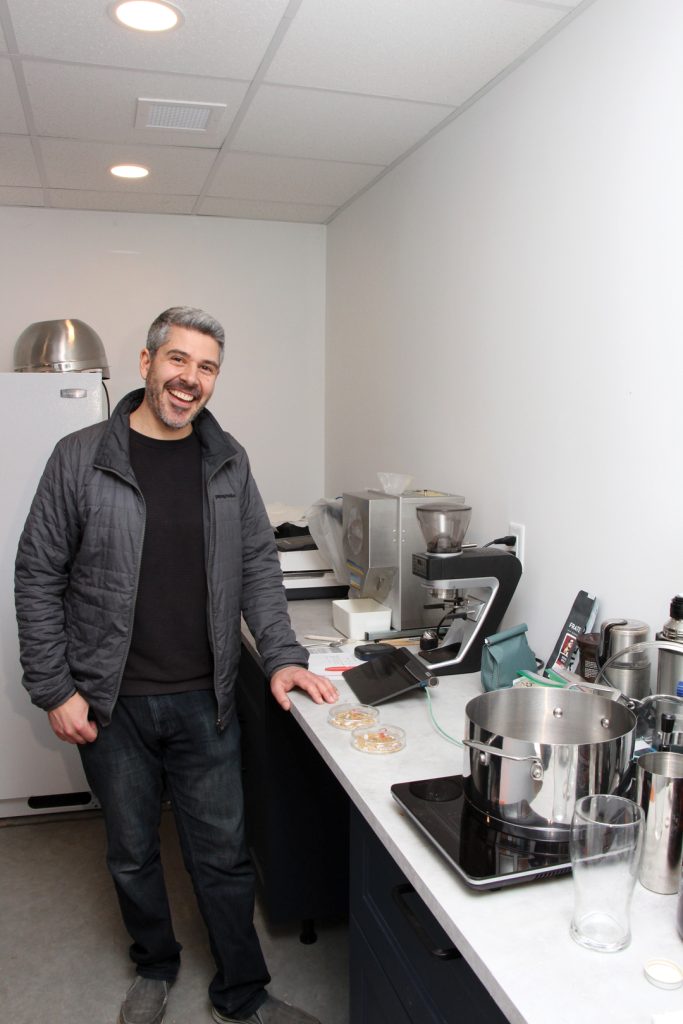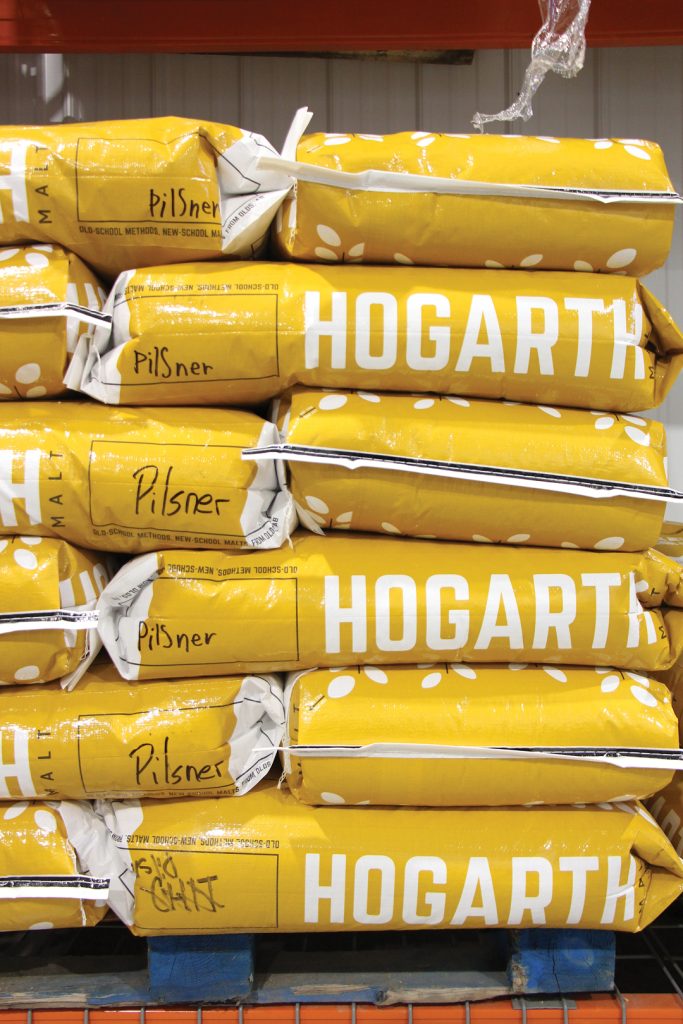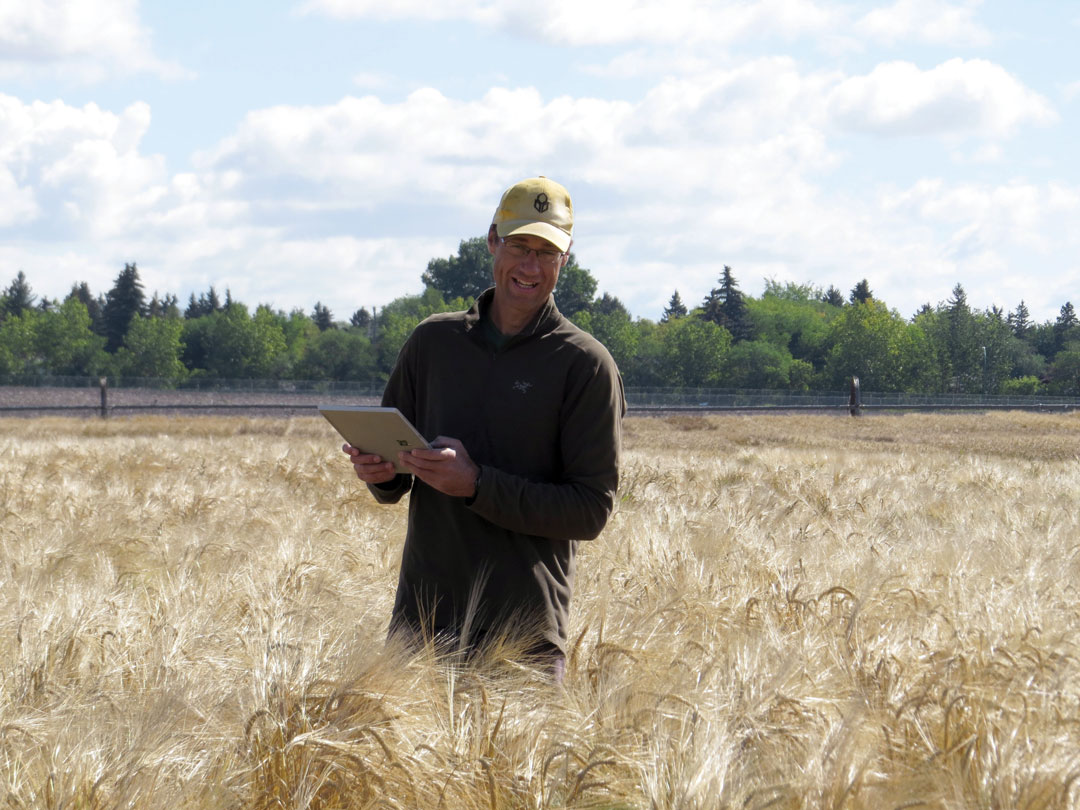FLOORED
BY IAN DOIG • HOGARTH PHOTOS BY ZOLTAN VARADI
Mike Foniok lights up when he talks about his work. A decorated veteran of Alberta’s craft beer scene, he is co-owner and head brewer of The Establishment Brewing Company. The Calgary business was named Canadian and Alberta brewery of the year in 2021.
Foniok is particularly enthusiastic about a new brand of malt. Located just northwest of Olds, Hogarth Malt produces locally grown, organic floor malt—more about this process shortly. Adjacent to The Establishment’s cozy taproom, Foniok shows off banks of oak casks in which the brewery ages its limited-edition beers up to three years. They are produced using traditional Belgian brewing practices that employ the brewery’s own wild yeast cultures. Hogarth malt is the central ingredient of these signature, barrel-aged beverages and the malt is gaining favour among Foniok’s fellow craft brewers.
A separate product line from the brewery’s main canned beer selection, The Establishment’s barrel-aged beer is sold in 750-ml glass bottles beautifully labelled with black and white illustrations by Alberta artists. “You experience the unique flavour and terroir of that malt, and that’s important to us,” said Foniok. “It tastes great, and it’s just freakin’ cool. How can we not use it?”

HOW IT’S MADE
With its bright fluorescent lights and shiny malting gear that trails tubes and cords, the Hogarth floor-malting room has the feel of a hospital operating theatre. In contrast to its clinical appearance, the air is invitingly fragrant with the sweet and earthy aroma of warm, moist malting barley in the germ stage.
On polished concrete to either side of a central gutter are two flattened, oval piles of tan barley. The thicker of the two piles, about a hand’s length high, was laid down the evening previous. When piled to a certain depth in a process known as couching, the grain generates a little of its own heat, which pushes the sprouting process along. The other pile is in its third day and will soon be roasted in the kiln.
Maltsters Aaron and Alex Hogarth constantly attend to the progress of multiple malt batches. The couple built this stand-alone facility and launched the business in September 2021. Aaron, also a master brewer, examined the progress of the youngest malt stack. The chitting process underway, delicate, creamy rootlets were visible on the kernels. “As the grain grows, we’ll spread it out further and further,” said Aaron, gesturing to the shallow pile. This turning and spreading is conveniently done with a device that resembles a massive rotary lawnmower. It’s a process the duo used to carry out with grain shovels. What previously took an hour-and-a-half of intense work now takes 10 minutes.
The sprout or acrospire of the three-day barley almost reach the bottom of the kernel, which will signify the batch is fully modified. “At that point, the enzyme package and the starch is available to the brewer,” said Aaron.
Prior to this stage, each 1,200-kilogram batch of raw barley spends two days in the steep tank off to one corner. In this tall chrome tank, the grain undergoes wet and dry phases until its ideal moisture content is reached. It is then transported to the malt floor in a simple, black fibreglass wheelbarrow. A batch will yield about a tonne of finished malt.
Approximately a four-day process, floor malting is time and labour intensive but less expensive than other systems. The set up will also simplify an eventual planned expansion. With the large floor they can quickly and cheaply expand production.

THE MALTING LIFE
The Hogarth malthouse features a pleasant meeting area decked out like a taproom. It’s a sunny space where the Hogarths can meet with clients and offer samples of various beer styles Aaron has brewed with their products.
The Hogarth roster includes a selection of base malts that includes pale, pilsner, Vienna and Munich. Specialty malts include rye, honey, roasted coffee and roasted chocolate. “We can go from biscuit-light and toasty to black malt and roasted barley, which are a lot like coffee,” said Aaron. “They add colour and character to dark beers.” They will soon introduce malted oats to the product line, which adds coveted haziness and body to New England IPAs.
Each month they deliver 25-kilogram bags and 250-kilogram totes to Edmonton and visit Calgary twice. The Establishment is their biggest client, but new customers have come onboard in recent months. “Everything’s growing faster and faster,” said Aaron.
“We’re a small malthouse. We’re not trying to become millionaires. There are better business ideas for that,” said Aaron. While they know their business is not a get-rich-quick scheme, the Hogarths are keenly aware of the inherent lifestyle strengths it provides. Their malthouse is a stone’s throw from their home, and extended family members on both sides live nearby. Connected to their community, they donate a portion of sales to local charities.
On the economic side, they produce a premium product for a sector that demands the best kind of creative self-indulgence. It’s hard work to produce this high-quality malt, but the job satisfaction is built in. This was obvious as Aaron and Alex sat and discussed their operation over beer from their own taps. They laughed often, gently chided each other over differences of opinion and finished each other’s sentences.
Both Aaron and Alex perform most malting duties, though Aaron handles more of the lab tests, such as germ viability and grain moisture content, and Alex takes on the greater share of paperwork. “We’re salespeople, delivery people, maltsters and lab geeks,” said Aaron. The couple’s three school-aged children are also slowly learning to perform malting tasks.
Aaron grew up in Lac la Biche near his family’s Wainwright farm. Several years ago, while he worked in Edgerton as a master brewer at Ribstone Creek Brewery, which won several Canadian Brewing Awards, he often spoke with farmers. “Just about every one of them would ask me, ‘I grow malt barley. Can you make some beer with it?’”
These farmer queries sparked an idea, and the planning process to launch Hogarth Malt began as Aaron worked part time as a brewer and consultant for various clients. While large maltsters produce product on a railcar scale, he envisioned a market niche for small-batch, farm-traceable varieties produced with traditional small-batch processes. “We can tell you the farmer, the field, the date the barley was harvested and what was put into the land to grow it,” said Alex. Aaron’s brewing expertise is another plus, she added. He speaks the language of their brewer clients and understands their needs.
Some of these needs are outside the brewing mainstream. “We can play with weird grains and processes the big guys would never even try on their scale,” said Aaron. One such malt is a melanoidin type they’ve dubbed Melany. When piled especially high, the amino acids and sugars in the barley react under anaerobic conditions to produce a product that gives beer a rich, slightly fruity maltiness and an attractive red hue. “It’s a really interesting product that no one else makes around here,” said Aaron.
Such products and the fact the grain is organic add to the brewer’s story, which is an important marketing tool. But quality, as the old Ford Motor Company slogan goes, is job one. “It’s got to be good product,” said Aaron. Quick turnover also allows the Hogarths to be fleet of foot as they switch gears to meet the shifting requirements of their clientele.
The malthouse’s timeline delivers additional value for brewers. “We don’t typically stock up way ahead of time. One of our advantages is freshness,” said Aaron. “A lot of the base malts come out of the kiln, maybe a week before they’re being used at the breweries.”
As inflation has increased in recent months, this has lowered availability and driven up the cost of imported U.K. and European malts. This has benefited Alberta maltsters as brewers have sought alternatives. For instance, local maltsters can provide substitutes for in-demand German malt varieties with the added benefit of being fresher than the import version. “There is a significant difference between fresh, local malt and malt that has maybe sat in a warehouse or on a boat for six months or longer,” said Aaron. “They are beautiful malts, but I think freshness is key.”
The Hogarths both admit making converts isn’t always so easy. “It can be tricky to talk brewers into making a substitution,” said Alex. “They are a finicky bunch. They like what they like.”

THE BARLEY SUPPLY
The Hogarths purchase organically grown Copeland malting barley for its proven track record in the malthouse. This spring, however, they will test very small quantities of Churchill and Cerveza to gauge their agronomic and malting performance.
Not far from the Hogarth malthouse, Chris and Leah Simeniuk operate a 1,400-acre certified regenerative organic grain farm. Their crops include wheat, barley, rye and mustard. They have sold barley to buyers in Colorado, Wyoming and Quebec, but deliver much of their crop to B.C.
When the Simeniuks took over the farm from Leah’s father in 2016, it was much smaller, which forced them to experiment with revenue options. Though Chris was not keen on organic farming at first, Leah’s father had begun to transition the farm in 2015, and they gave it a try. With the incorporation of cover crops and regenerative practices as well as lessons learned during the farm’s conventional, no-till years, the approach proved a success. As Kettle Ridge Organics took off, the pair took on additional acres.
Though they’ve grown Kindersley and Metcalfe in the past, Copeland is their malting barley mainstay. “If it ain’t broke, don’t fix it,” said Chris. “Yield is good and it competes well with weeds. It’s easy to keep the protein low and the plump high.” One of few organic barley farmers in the area, their product sells well.
With their mutual interest in barley, the Simeniuks met the Hogarths through social media. Though Hogarth Malt is the Simeniuks’ smallest customer by far, they are keen to support the business. “It’s not a huge income stream for us yet, but it’s nice to work with a local entrepreneur,” said Chris.
Hogarth and Kettle Ridge even recently teamed up with Hawk Tail Brewery in Rimbey on a farm-to-table beer collaboration. “It’s neat to be able to say, ‘Hey, this is the result of our hard work,” said Leah. “We can drink that beer and say, ‘Look what we did.’”

A MALT-FORWARD FUTURE
The Hogarths made the first sale of malt produced within their malthouse in December 2021. With COVID uncertainties, initial sales were slow. Brewers held off trying new ingredients while they struggled to adjust their pandemic business models. This changed in spring 2022. “Things started really rolling because brewers were free to take risks,” said Alex.
Hogarth Malt now produces four tonnes of product per month with the goal of 10 tonnes. If all goes well, they plan to substantially increase their production over the next year or two. This will require additional staff to augment the part-time student employees they hire from the Olds College Brewmaster and Brewery Operations Management diploma program.
The Hogarths’ overarching ambition is to fuel the growth of Alberta’s craft brewing industry. “Alberta can become one of the most interesting, malt-forward beer hubs in North America,” said Aaron. Alex agreed and suggested brewers are welcome to pick Aaron’s brain. “Challenge me,” said Aaron with an emphatic nod. “Let’s see what we can do together.”








Comments